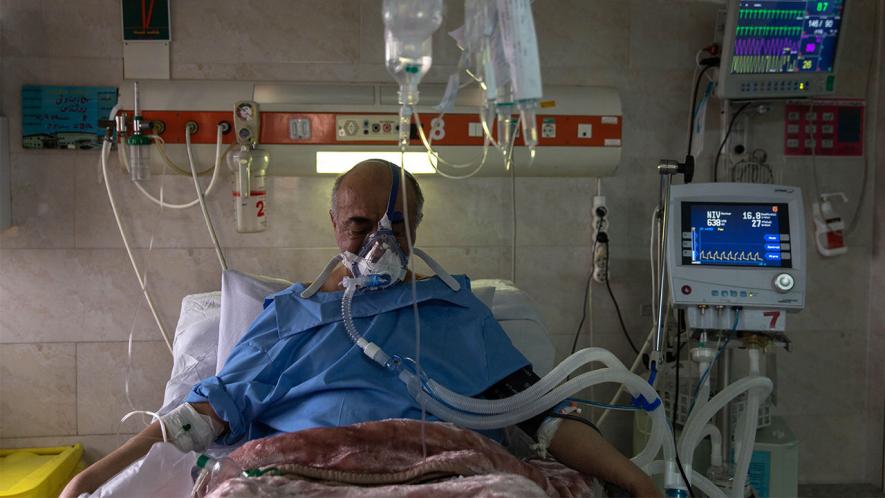COVID-19: Complexity of Lung Infections in Patients Reveals New Lines of Treatment

Representational Image. Image Courtesy: Science
In severe cases of COVID-19, the patient’s lungs are damaged, a condition similar to pneumonia. Breathing problems begin to develop and if the situation deteriorates further, it could lead to death too. Again, in the average case, a pneumonia patient suffers from hypoxia, the condition of an extraordinarily low-level oxygen in blood. In such a situation a patient finds it terribly difficult to breath oxygen in, and the lungs inexorably crave for it.
However, something strange has emerged in the case of patients with COVID-19. Those with hypoxia patients do not find themselves in trouble while breathing oxygen into their lungs. The monitoring system might continuously display a low-level blood oxygen reading, but a patient might not find it too uncomfortable. ‘Happy hypoxics’ is the term that clinicians now use to describe such patients.
The normal blood-oxygen saturation level is 95% at the least. It is obvious that in more severe cases, patients ultimately struggle to breathe with the enormous damage to their lungs. But, in some cases of COVID-19, prior to this condition being reached, obvious respiratory difficulties do not arise, even at a low saturation level. Carbon dioxide levels inside the body can remain normal and breathing deeply can also be done with sufficient comfort. Doctors are now keen to understand this hypoxia.
Many doctors have recognised that blood clotting is a major feature in severe COVID-19 patients. Elnara Marcia Negri, a pulmonologist in Sau Paolo, Brazil, says that clotting might begin early in the lungs. This, perhaps, can be put down to the inflammatory reaction in the web of tiny blood vessels in the lungs. As a result of this inflammatory reaction, a cascade of proteins promoting blood clotting could be activated and consequently, prevent the lung from getting oxygenated properly.
Negri hit upon the idea when one of her patients experienced breathing difficulties accompanied with circulatory problems in her toes. Negri gave her Heparin, a widely-used blood dilator. Surprisingly, not only did the circulatory problem go away, but her breathing difficulties were also a thing of the past. Negri reported her experience of treating the COVID-19 patients in the pre-print server MedRxiv. Her team used Heparin on 27 COVID-19 patients with hypoxia and the dose was increased when an elevated level of D dimer was found. The D dimer is a blood marker that denotes excess clotting. She posted it on April 20.
Out of the 27 patients, 24 are reportedly recovering. The number includes six of the eight patients that required mechanical ventilator. Two are still critically ill. Negri now plans on using her treatment on more patients. On the absence of discomfort in breathing among patients with hypoxia, at least at an early stage, Negri opines that it could be due to the inflation in the lungs, probably due to the inflammatory reactions.
Backing her idea, Reuben Strayer, an emergency physician at Maimonides Medical Centre, New York, finds it reasonable to believe that hypoxia emerges due to clotting in the small vessels of the lungs. His own hospital is planning on finding markers of blood clotting and using a blood thinner. “But it is simply not known whether clotting causes ‘happy hypoxia’,” says Strayer. There are other possibilities as well. Imaging of a hypoxic patient showed a waxy-looking film around the lung.
Many facets of the lung condition need to be deciphered, which is the foremost cause of deaths of COVID-19 patients. An emerging view is also that doctors should not hastily resort to aggressive treatment. Luciano Gattoni, a guest professor of intensive care in the Gottingen Medical Centre wrote in the JAMA (Journal of American Medical Association) about aggressive treatment where doctors hastily apply ventilators or oxygen in high pressure to inflate the lungs. In case of a lung being already inflated and when a patient finds it uncomfortable to breathe, the application of such measures could cause more harm, he believes. However, those measures are essential when a patient is not helped by non-invasive treatment.
Following another line of mild treatment, Reuben Strayer, Nicholas Caputo, an emergency physician at New York city Hospital, and Richard Levitan, another physician, gave COVID-19 patients supplemental oxygen while they were flipped on their belly. This is an approach where the lower lungs are opened in patients on ventilators. The trio published their report in American Emergency Medicine where they said that among 50 patients treated in such a manner, the low saturation levels were raised significantly but that 13 patients were not helped and needed intubation within 24 hours.
The data from COVID-19 has shown many unknown features of the pathophysiology of the virus till date. Doctors and scientists worldwide are trying hard to understand these; however, uncertainty remains. What remains, is hope is their relentless efforts to unfold the severity of the disease and also the virus.
Get the latest reports & analysis with people's perspective on Protests, movements & deep analytical videos, discussions of the current affairs in your Telegram app. Subscribe to NewsClick's Telegram channel & get Real-Time updates on stories, as they get published on our website.














